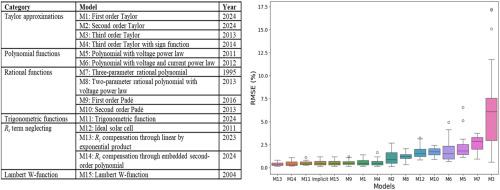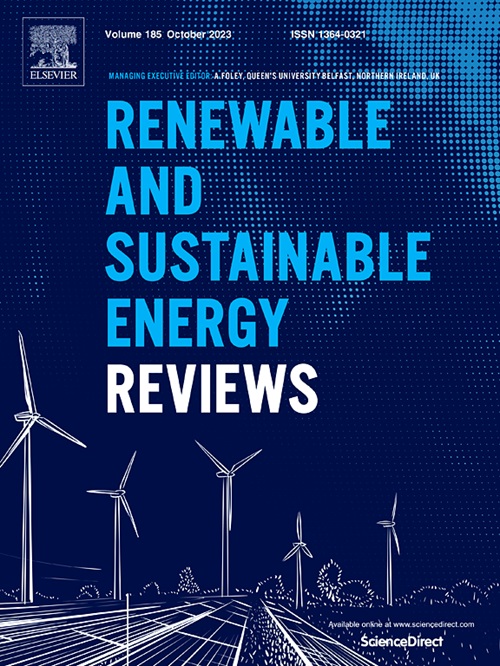光伏电池电气特性的显式模型综述
IF 16.3
1区 工程技术
Q1 ENERGY & FUELS
引用次数: 0
摘要
对于太阳能电池建模而言,单二极管模型在实施上存在困难,而且计算成本高昂,因为它涉及一个超越和隐含的数学方程。一些学者提出了近似其行为的显式、易用且计算效率高的模型。为每种特定应用选择合适的模型具有挑战性,因为不同的建议针对不同的太阳能电池板、运行条件和性能指标进行了测试,因此无法根据已发布的信息进行直接比较。在本研究中,对现有的显式模型进行了回顾,介绍了它们的方程并讨论了它们的数学近似值。此外,还介绍了四种新模型,并提出了模型分类方法。此外,还使用相同的性能指标和参数提取方法,对多种光伏技术和运行条件下的所有模型进行了比较分析。这样就可以建立一个框架,使每个应用更容易选择模型。比较结果表明,研究团队提出的三个模型比隐式方法更准确,平均均方根误差低至 0.41%(而隐式模型的误差为 0.54%)。然而,这些模型中的参数缺乏物理意义。在包含物理参数并采用基本函数的显式模型中,最精确的是基于一阶帕代近似的模型(误差为 0.55%)。模型排序有望成为光伏界在各种太阳能电池建模任务中的重要工具。本文章由计算机程序翻译,如有差异,请以英文原文为准。

Review of explicit models for photovoltaic cell electrical characterization
For modeling solar cells, the single diode model presents difficulties in implementation and is expensive computationally because it involves a transcendental and implicit mathematical equation. Some authors have proposed explicit, easy-to-use, and computationally efficient models that approximate its behavior. It is challenging to select the proper model for each specific application because the different proposals were tested for different solar panels, operating conditions, and performance metrics, and, therefore, a direct comparison based on the published information is not possible. In this study, the existing explicit models are reviewed, presenting their equations and discussing their mathematical approximations. Four new models are introduced, and a classification of models is proposed. Furthermore, a comparative analysis of all the models under many photovoltaic technologies and operating conditions is carried out using the same performance metrics and parameter extraction method. This allows developing a framework that makes the selection of models easier for each application. The comparative results show that three models proposed by the research team are more accurate than the implicit approach, with average root mean squared errors as low as 0.41 % (versus 0.54 % error of the implicit model). However, the parameters in these models lack physical sense. Among the explicit models incorporating physical parameters and formulated with elementary functions, the most accurate is based on a first order Padé approximation (0.55 % error). The ranking of models is expected to become a valuable tool for the photovoltaic community in various solar cell modeling tasks.
求助全文
通过发布文献求助,成功后即可免费获取论文全文。
去求助
来源期刊

Renewable and Sustainable Energy Reviews
工程技术-能源与燃料
CiteScore
31.20
自引率
5.70%
发文量
1055
审稿时长
62 days
期刊介绍:
The mission of Renewable and Sustainable Energy Reviews is to disseminate the most compelling and pertinent critical insights in renewable and sustainable energy, fostering collaboration among the research community, private sector, and policy and decision makers. The journal aims to exchange challenges, solutions, innovative concepts, and technologies, contributing to sustainable development, the transition to a low-carbon future, and the attainment of emissions targets outlined by the United Nations Framework Convention on Climate Change.
Renewable and Sustainable Energy Reviews publishes a diverse range of content, including review papers, original research, case studies, and analyses of new technologies, all featuring a substantial review component such as critique, comparison, or analysis. Introducing a distinctive paper type, Expert Insights, the journal presents commissioned mini-reviews authored by field leaders, addressing topics of significant interest. Case studies undergo consideration only if they showcase the work's applicability to other regions or contribute valuable insights to the broader field of renewable and sustainable energy. Notably, a bibliographic or literature review lacking critical analysis is deemed unsuitable for publication.
 求助内容:
求助内容: 应助结果提醒方式:
应助结果提醒方式:


